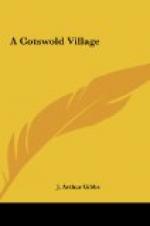When Charles II. escaped from Worcester he put up at an old hostelry in Cirencester called the Sun. King James and, still later, Queen Anne paid visits to this town.
Altogether the town of Cirencester is a very fascinating old place. The lot of its inhabitants is indeed cast in pleasant places. The grand bracing air of the Cotswold Hills is a tonic which drives dull care away from these Gloucestershire people; and when it is remembered that they enjoy the freedom of Lord Bathurst’s beautiful park, that the neighbourhood is, in spite of agricultural depression, well off in this world’s goods, it is not surprising that the pallid cheeks and drooping figures to be met with in most of our towns are conspicuous by their absence here. The Cotswold farmers may be making no profit in these days of low prices and competition, but against this must be set the fact that their fathers and grandfathers made considerable fortunes in farming three decades ago, and for this we must be thankful.
The merry capital of the Cotswolds abounds in good cheer and good fellowship all the year round; and one has only to pay a visit to the market-place on a Monday to meet the best of fellows and the most genial sportsmen anywhere to be found amongst the farming community of England.
One of the old institutions which still remain in the Cotswolds is the annual “mop,” or hiring fair. At Cirencester these take place twice in October. Every labouring man in the district hurries into the town, where all sorts of entertainments are held in the market-place, including “whirly-go-rounds,” discordant music, and the usual “shows” which go to make up a country fair. “Hiring” used to be the great feature of these fairs. In the days before local newspapers were invented every sort of servant, from a farm bailiff to a maid-of-all-work, was hired for the year at the annual mop. The word “mop” is derived from an old custom which ordained that the maid-servants who came to find situations should bring their badge of office




